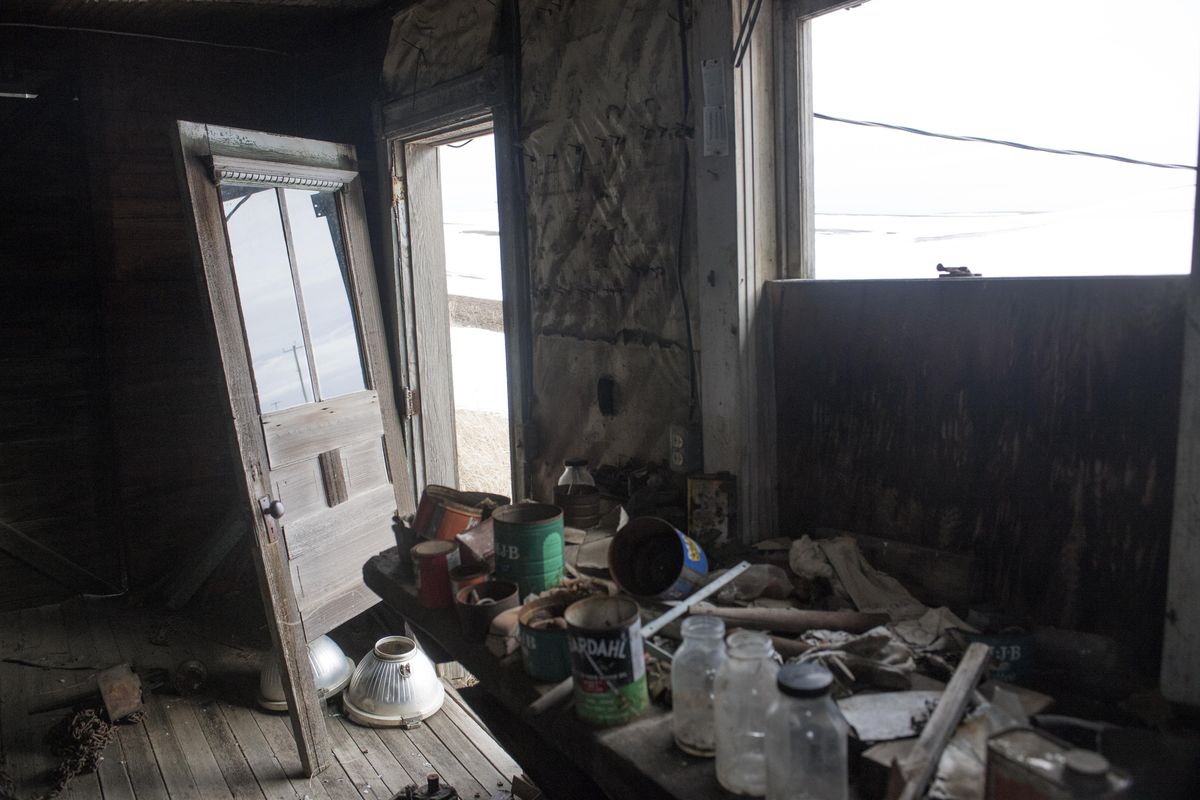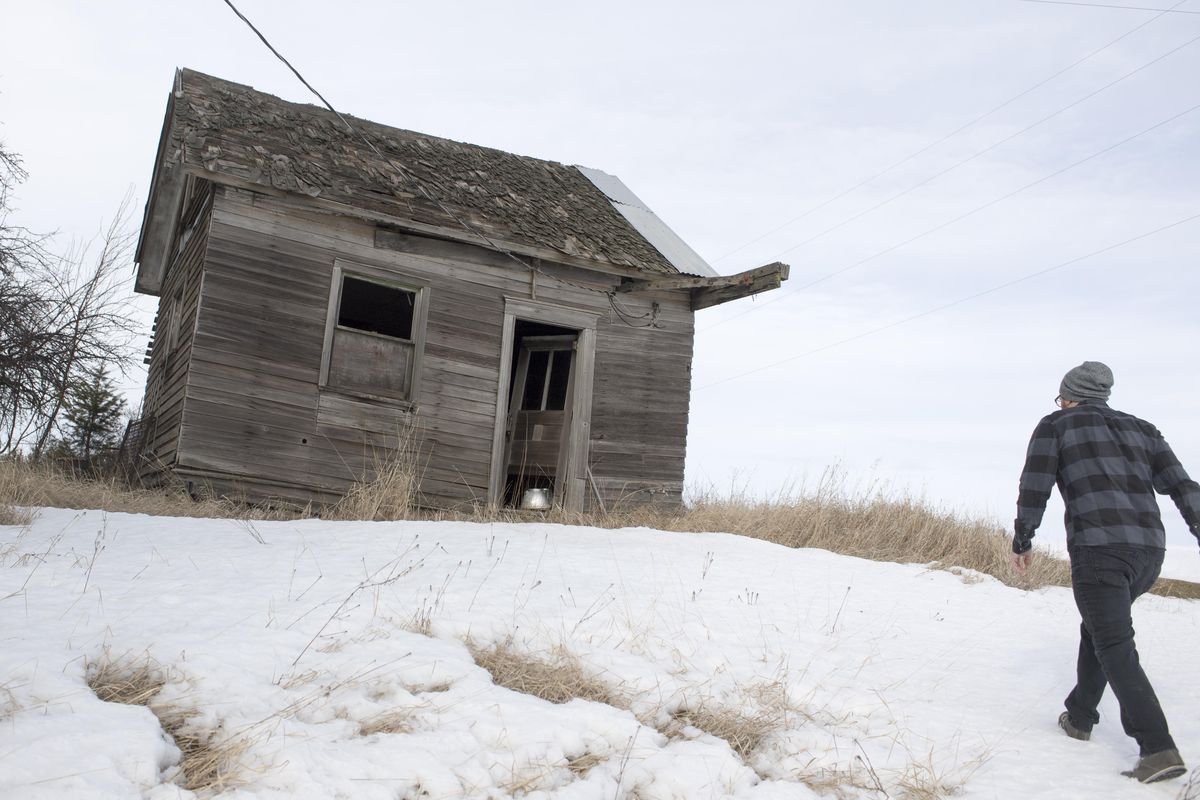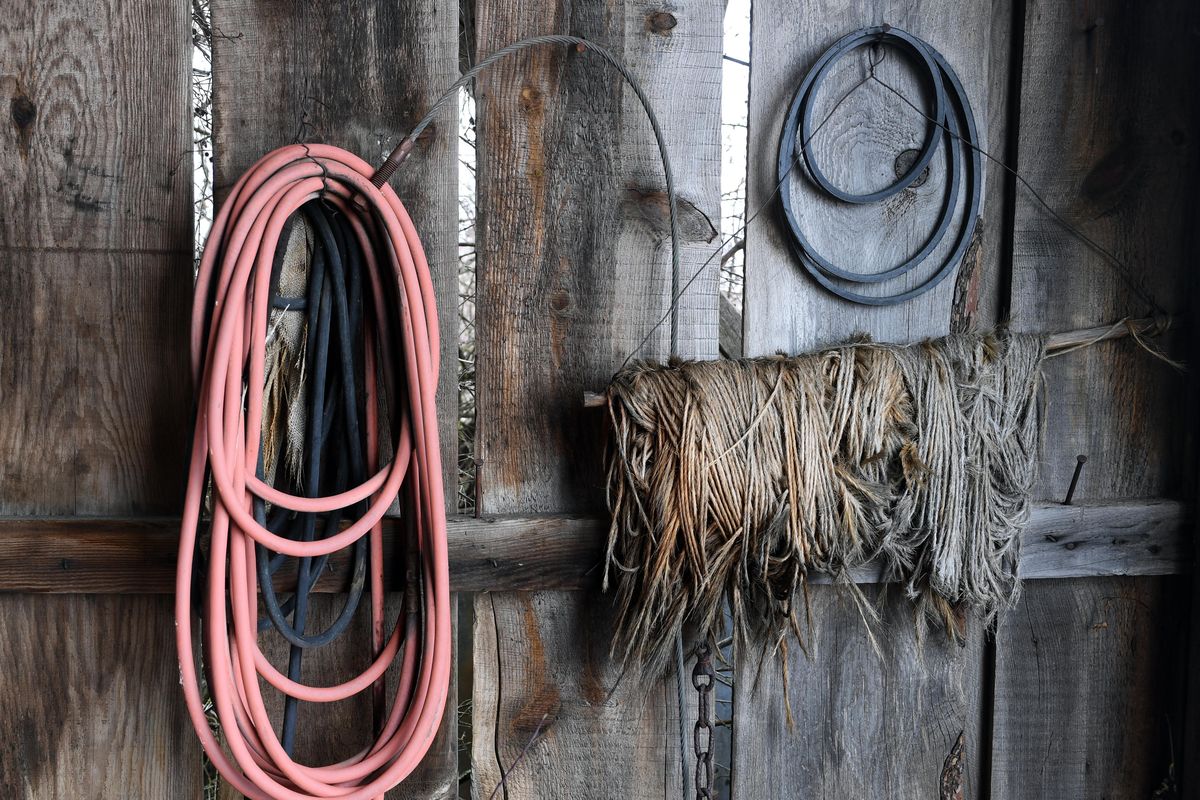Spokane’s urban explorers look for the humanity in abandoned places, but there are risks
Jan. 30. (Jesse Tinsley / Jesse Tinsley/THE SPOKESMAN-REVIEW)Buy a print of this photo
Jeff Torres grabbed the handle and nudged the door open as he slowly peeked his head inside.
“Hello?” he shouted.
His words echoed through all three vacant floors of the farmhouse.
“I never want to be caught off guard,” he said, after a long, silent pause.
He swung the white door to the side and slowly entered. Now inside and sure no one else was, he could freely navigate the rooms as like a real estate agent showing a promising property..
“This room is my favorite,” he said, showcasing his impressive knowledge of the house’s layout. “Look at this door over here, see the window on it?”
The thing is, the property isn’t new, and the house showed signs of having been abandoned decades ago, by Torres’ estimation. The dirt and dust caking nearly everything, and the dead bird in the corner, seemed to support his hypothesis. Not to mention the back door, which was not only unlocked, but unlatched.
“This closet over here is really cool,” he said, pointing to short doorway that opens up to the size of a small room.
This is Torres’ third time in the house. Since he began this new hobby a year ago, this particular farmhouse in this particular forgotten piece of land off this particular state highway in Whitman County is his absolute favorite.
He’s been to dozens of other places: an old mining mill in Idaho, a small ghost town in rural Washington, an abandoned church a few miles outside of Reardan, and a “dead motel” in Idaho, to name a few. On each trip, he brings a GoPro mounted to a stabilizer and records the whole thing, which he edits and uploads to his YouTube channel, Jeff Explores.
But for him, this one has all the pickings of a good exploration: a lived-in feeling with years of history, leftover furniture with compelling evidence it was once loved, and the three 1950s-style refrigerators in the dark, damp and creepy basement.
“I like to open them,” he says, as he pulls one of the latches. It’s empty.
Torres’ hobby is lovingly referred to as urban exploration, or urbex. He and other explorers around the world share a fascination with trudging through places that time and people seem to have forgotten.
Even though urban exploring is often illegal, and the risk of being caught can be high, it doesn’t seem to matter.
“There’s kind of this naughty factor of somebody being where they’re not supposed to be,” Torres said in a phone interview in December. “I guess I’m kind of chasing that high.”
Urbex: a strange world
Pick an Inland Northwest area on a map, and chances are someone has explored – or attempted to explore – something abandoned there. Every few months, a post surfaces on Reddit asking for recommendations on places to explore near Spokane, with dozens of upvotes and responses sharing tips.
But it isn’t a new phenomenon. Larry Cebula, a professor of public and digital history at Eastern Washington University, theorizes the origins of the hobby can be traced back to the early modern period between 1450 and 1750, though it had a different name back then.
“This is a very old fascination,” he said. “Lord Byron used to explore abandoned ruins. It was just fascinating to them at the time.”
Pretty much everywhere on Earth there are signs of explorers or just normal people who became enamored with discovering that area’s secrets, Cebula said.
“There’s a human element there, an element of a ghost story, about how past lives interacted with that space,” he said. “And we’re trained from childhood with stories of buried treasure, to be fascinated with old and forgotten places.”
In the Inland Northwest, there are myths aplenty about which places are actually abandoned, not to mention open to the public.
Places like the Ridpath Hotel, which closed in 2008, or the long-shuttered Kaiser Aluminum smelter in Mead, are usually high on the list of places that are accessible and definitely abandoned – even though they both have multiple no-trespassing signs and take good measures to keep people out.
One Reddit user, who wished to remain anonymous, recounted a night he and a few friends hopped the fence and explored the old Kaiser smelter’s many acres of buildings.
“We’re adventurous by nature and sometimes choose to ignore rules, so we said to hell with it and went on in,” the person wrote. “Spent probably 4-5 hours in the middle of the night exploring most every building.”
Then there are the not-too-well-known spots. Places like the old Air Force-owned Nike and Atlas E missile silos installed in the Spokane area during the Cold War.
While some people may know they exist, or remember when they were installed, they probably don’t know where they’re located – especially since most of them are now privately owned.
“There were a number of them that ringed Spokane,” said Robert McCoy, an associate professor of history at Washington State University. “When you mention that to people here in particular, they don’t understand it.”
In one of Torres’ videos titled “URBEX - Nike Missile Site…Abandoned?!” he appears to have stumbled across an old silo in rural Washington. While he tries to do his homework ahead of time, he later admitted it could have been something else.
“I had heard of a missile silo near Spokane, a Nike missile site,” he wrote in a Reddit message two months ago. “And, a few other places before I started exploring.”
But Torres doesn’t like the “touristy spots” that get posted on forums and message boards or have any place in a history book. He enjoys the properties only he knows about, which is why many serious urbexers will never divulge a personal favorite location.
“It’s kind of a code that most urban explorers have,” he said.
Torres’ usual method of finding a new place is as simple as spending a day looking on Google Maps.
“I’ll just kind of scout out farm areas,” he said. “If I see something in question, I can kind of guess its condition by the state of the roof. Usually you can see if the roof looks new or not. The surrounding grass might look dead. I’ll put a marker down and spend my days off driving around.”
In fact, while heading to his favorite spot in Whitman County, he turned his head in the middle of the conversation and pointed his finger toward a small cluster of houses in the distance.
“Those are some abandoned houses right there,” he said. “That’s the first time I’ve noticed them.”
***
On the way to the upper floor, there’s a large wooden gun rack hanging above the staircase. The wallpaper is stained and peeling. The ceiling paint looks even worse.
The house is big from the outside, but inside it feels even larger. There are four rooms upstairs, some with funky doors that have windows on them looking into the hallway, others that show signs that someone attempted to take a carpet, but gave up halfway through folding it.
One room is completely bare of wallpaper, paint and carpet. A small furnace and an empty safe sit in the middle of the room, with piles of junk around and between them.
The biggest room toward the front of the house has a window overlooking the highway and surrounding area. Parts of the ceiling are gutted, with electrical wires exposed and things to snag your ear on.
***
Ask urban explorers why they got into the hobby in the first place, and the answers may be different each time. Some do it because they want to feel closer to history, others do it because they like the rush.
Zane Olson, a Spokane resident who’s mostly explored on the East Coast while occasionally dabbling a bit in the Inland Northwest, said he first fell in love with exploration as a kid, when his parents took him to the Seattle underground tour in Pioneer Square.
“Usually someone gets bored of it, but it was cool seeing all of the old stuff, just kind of imagining what stuff was going on there,” he said while sipping an Americano one rainy December evening in a downtown coffee shop.
Another Reddit user who wished to remain anonymous became enamored with the aesthetic and decay of old buildings.
“I also like to see the ‘behind the scenes’ stuff – pipes, equipment, storage rooms, and other stuff like that,” the person wrote. “I like knowing something most other people don’t know, or seeing things most other people will never see.”
According to McCoy, the WSU professor, people often romanticize the history of certain areas. In his experience as a historian and advocate for historic preservation, people often become attached to the stories these places appear to tell, whether they’re true or not.
It’s the mystery and lack of answers that draws people in, he said.
“There’s no story other than what’s there, what’s left,” he said. “People can use their imaginations to think up all kinds of different stories about what happened, why it’s derelict, why it’s crumbing to the ground…They sense that history is kind of incomplete; that we can’t ever get to the full total of what people thought or did.”
Perhaps no place is better at telling untold stories than Pripyat, the ghost town in northern Ukraine near Chernobyl, which was quickly abandoned in 1986 after a catastrophic nuclear disaster. For many urban explorers, the area is the “Holy Grail” of abandoned places.
McCoy said this makes sense. While not on the same scale as Chernobyl, when the Kaiser Aluminum smelter closed in 2000, it left behind acres of land and dozens of buildings.
What’s more, there are still jackets hanging on coat hangers, files and timecards left on desks and full toilet paper rolls in some bathrooms.
“Those places are really appealing because they show things that people didn’t talk about,” McCoy said. “And people don’t really talk about industrial places. We don’t talk about where we get things, or where things are produced.”
***
A few hundred yards away from the farmhouse is what looks to be an old general store that for years has been slowly sinking into a bog. The foundation is leaning to one side, and mud and water have claimed about a foot of foundation.
Two large windows in the front of the building are unbroken. If patrons were there today, they’d have a perfect view of an enormous cottonwood tree overtaking much of the front yard and roof.
The door frames are all sloping to one side, and look like something Tim Burton would design.
In one corner of the front room is a shopping cart. And in another, perhaps the remnants of an old cash register.
***
Eastern State Hospital, a psychiatric facility in Medical Lake, is well-known in Spokane. But one of its lesser-known features is the shuttered Medical Lake Primate Field Station, which closed in 1996.
Run by the University of Washington, the station once housed thousands of primates used for dozens of research projects, from AIDS to testing alcohol’s effects on the brain.
The building it once occupied is now empty. And for explorers, it’s a prime spot. Olson, who became more interested in exploring the hospital’s abandoned buildings after watching the John Carpenter film “The Ward,” which was filmed there, said he hasn’t explored the hospital, but it’s been on his list.
“I’ve always been curious about it,” he said.
Joey Frost, a spokeswoman for the hospital, said she’s gotten many requests to tour the hospital’s abandoned buildings.
“We tell them, for obvious safety concerns and reasons, that we do not allow anybody to go into any of the buildings on the hospital campus that are abandoned,” she said. “That’s not something we can allow.”
Owners of the former Kaiser smelter were unable to be reached for a full comment, but did indicate problems with people exploring the factory in the past, even with a barbed-wire fence surrounding the entire facility.
Mark Gregory, spokesman for the Spokane County Sheriff’s Office, said deputies have been dispatched to the facility before, but most trespassing calls are for houses.
“We’ve gone up there before,” he said. “It seems like, when there was a ton of abandoned or foreclosed homes in 2008, 2009, there were more. But do we get calls about people trespassing? Yeah.”
In Whitman County, where abandoned farmhouses, barns and grain silos are scattered across the Palouse, Sheriff Brett Myers said it’s not uncommon for people to get caught trespassing.
“There’s people that are actually out there looking for things to steal, then there are people out there who find stuff and think nobody has ever found it before,” he said. “It’s not finders keepers like some people think.”
Someone caught on a property could be charged with criminal trespass and, in a most serious case, face a year in jail.
If discovered in a house, a person could be charged with burglary – regardless of whether something was stolen.
“The big takeaway is, almost all property out there belongs to someone,” Myers said. “Sometimes people think, ‘oh someone isn’t interested in this barn,’ so they’ll take some wood or tractor parts. They didn’t find it. It’s stolen.”
But for all urban explorers interviewed for this story, none of them said they had ever stolen anything from a place they visited. In fact, most of them adhere to a strict set of “rules.”
Rules such as: always bring a friend in case you get lost or hurt; try to ask for permission before entering a new area; never steal anything; leave it the same way you found it; never force a way in through doors or windows; and in general, try not to get into trouble.
Following the rules has kept Torres out of trouble, though with the places he visits, he figures the homeowners have long stopped caring about the property.
With many of them, he’s more worried about running into squatters or wildlife than anything else.
“I understand that some of these places might be where people are living and I don’t want to encroach on their space,” he said. “I explore for footage, not for encounters.”
***
Back in the basement of his favorite abandoned house, surrounded by the old refrigerators and a large furnace, Torres stood next to a shelf with about a half-dozen canning jars containing something brown that likely had been something delicious decades ago. Yet, three or four contain what looked like fresh, bright orange peaches as perfect as the day they were put up.
It’s easy to imagination the person who canned them; the love and care put into each one, the anticipation of eating them, he said.
It’s interesting to imagine what happened – why they left in such a hurry, why the house is empty or why almost everything is gone, save for a few refrigerators and peaches.
A Spokesman-Review clipping from Sunday, April 25, 1993, rested in the dirt, offering a reminder of the times.
“To me, the perfect places are recently abandoned,” Torres said, his eyes passing over canned peaches. “And I personally like the houses more because people lived there. There’s a human connection here.”










